
The Project Gutenberg EBook of The Mentor: The Cradle of Liberty, Vol. 6, Num. 10, Serial No. 158, July 1, 1918, by Albert Bushnell Hart This eBook is for the use of anyone anywhere at no cost and with almost no restrictions whatsoever. You may copy it, give it away or re-use it under the terms of the Project Gutenberg License included with this eBook or online at www.gutenberg.org/license Title: The Mentor: The Cradle of Liberty, Vol. 6, Num. 10, Serial No. 158, July 1, 1918 Author: Albert Bushnell Hart Release Date: March 25, 2016 [EBook #51556] Language: English Character set encoding: UTF-8 *** START OF THIS PROJECT GUTENBERG EBOOK THE MENTOR: THE CRADLE OF LIBERTY *** Produced by Juliet Sutherland and the Online Distributed Proofreading Team at http://www.pgdp.net

LEARN ONE THING
EVERY DAY
JULY 1 1918
SERIAL NO. 158
THE
MENTOR
THE CRADLE OF
LIBERTY
By ALBERT BUSHNELL HART
Professor of Government
Harvard University
DEPARTMENT OF
HISTORY
VOLUME 6
NUMBER 10
TWENTY CENTS A COPY
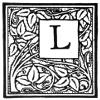
Liberty is older than Law, older than Government, older than the State. Liberty goes back to the Garden of Eden, where first was taught the bitter lesson that where Liberty is uncontrolled, society breaks down. The word is a splendid one, coined by the Romans, “With a great price obtained I this freedom,” said the Roman centurion; “But I was free born,” replied St. Paul. Liberty was in the hearts of the English colonists; Liberty rang out from the Bell of Independence Hall; Liberty is stamped upon our state and federal constitutions. For Liberty millions of men have struggled and died. Toward Liberty oppressed myriads are stretching out their hands today. Liberty is the pole-star of peoples, the hope of mankind.

FANEUIL HALL, BOSTON, MASS.—“THE CRADLE OF LIBERTY”
ONE
“In old Faneuil, that guild temple of traders and aldermen, butchers and clerks, hucksters and civic magistrates, the spirit of the people conceived an embryonic nation.”
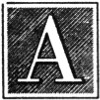
Among early Bostonians who owned argosies and had a prosperous trade with France and England was a young bachelor named Peter Faneuil, who, like Paul Revere, was descended from Huguenot refugees. He was the heir of his uncle, Andrew Faneuil, who died in 1738 and left a large fortune. Fond of good living and hospitable, “Here’s to Peter Faneuil!” was the toast often proposed above brimming bumpers. From Madeira he ordered amber wine, from London, chariots and sets of crested harness, and fine stuffs, buttons and laces. His ships carried cargoes of tobacco, black walnut, fish, stoves and general merchandise. At forty years of age he was a prince among Colonial merchants. He had, moreover, pride in Boston’s advancement, and offered “at his own cost and charge” to build a market for “the use, benefit and advantage of the town.” Later, the donor of the market house instructed his architect, the renowned John Smibert, to add a hall above the space given over to provisioners’ stalls. In 1742 the two-story brick building was completed. When Peter Faneuil received the formal thanks of Boston, he made the prophetic response, “I hope what I have done will be for the service of the whole country.” A year later he died, and was buried in the Granary Burying Ground.
The chamber over the market became the seat of public offices, and, as the Town Hall, was in demand for patriotic celebrations, debates and banquets. In 1761, all of the structure except the walls was destroyed by fire. As no benevolent townsman offered to duplicate Faneuil’s gift, the selectmen were empowered to raise the necessary funds for rebuilding by holding a lottery. “Faneuil Hall Lottery Tickets” bore the signature of John Hancock, then a young politician of promise. In 1763 the reconstructed Town Hall was ready for occupancy. It was this rebuilt meeting-place that became the forum of free speech in Boston, the Altar of Liberty from which rose the flame that “roused a depressed people from want and degradation. Here those maxims of political truth which have extended an influence over the habitable globe, and have given rise to new republics, were first promulgated.”
The Stamp Act (1765) was denounced within its arched and pillared walls, and the repeal celebrated with festivities. Revenue laws were discussed, and when troops were ordered to the provincial capital, a convention in session here raised a fearless voice in defence of Colonial independence. The day following the massacre of the fifth of March, 1770, a mass meeting was called in the Hall, but so many citizens responded that it was necessary to repair to Old South Church, where there was more room. Early in November, 1773, John Hancock presided over a Town Hall meeting, the object of which was to protest against threatened importations of tea by the East India Company of London. At numerous conclaves the tea question continued to agitate the grave townsfolk, until on December sixteenth a group of patriots in the disguise of Indians summarily put an end to discussion by dumping the cargoes of the newly-arrived tea ships into Boston harbor.
Faneuil Hall echoed to vigorous protests against the Port Bill, which so vitally affected Boston commerce, and from the same “Old Faneuil” printed letters were dispatched to the other colonies for the purpose of presenting facts and securing coöperation against proposed aggressions by the mother country. At Faneuil Hall representatives of General Gage assembled one tragic day to receive the arms of the Bostonians. In joyous contrast were the meetings held in the honored edifice after the evacuation of the city by British troops.
French naval officers and the Marquis de Lafayette were feasted here; two presidents, George Washington and John Adams, were guests of honor at Faneuil Hall banquets; and in 1793 the execution of Louis XVI was celebrated by sons of freedom who sympathized with the French Revolutionists.
In the year 1806 the sturdy building was remodeled and enlarged. During the naval war with England, citizens again held meetings in the Town Hall to inveigh against renewed violations of their “national rights and sovereignty.” In the “Cradle of Liberty” Charles Francis Adams, Daniel Webster, Wendell Phillips, Edward Everett, Rufus Choate and Charles Sumner championed justice and democracy. In 1834, at a memorial meeting for Lafayette held in Faneuil, Edward Everett delivered one of his most glowing and eloquent orations, in which he extolled the departed French patriot as the “Lover of Liberty.” Referring to the Hall in which he spoke, he said, “The spirit of the departed is in high communion with the spirit of this place.”
PREPARED BY THE EDITORIAL STAFF OF THE MENTOR ASSOCIATION
ILLUSTRATION FOR THE MENTOR, VOL. 6, No. 10, SERIAL No. 158
COPYRIGHT, 1918, BY THE MENTOR ASSOCIATION, INC.

OLD NORTH CHURCH, BOSTON, MASS.—Associated with the Ride of Paul Revere
TWO
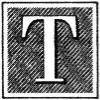
Though Paul Revere performed bravely and well numerous patriotic duties assigned to him, most early historians of the Revolution forgot even to mention his name in recounting the crucial events of April, 1775. He lives in our memory today chiefly because one valorous deed of his, in that month of valorous deeds, was made the subject of a popular poem. Nearly ninety years after the Ride, Longfellow rescued the Midnight Messenger from oblivion, and gave him a place among Revolutionary heroes.
Apollos Rivoire, father of Paul, was a native of the Island of Guernsey, and came of Huguenot stock. A fugitive in search of freedom, he found a home in Boston, where on January 1, 1735 (new style), the son was born who was to establish in the annals of his country the Anglicized name of liberty-loving French ancestors. Father and son were metal craftsmen and wrought fine tableware, many examples of which are still in existence. Paul was a skilful designer, and a cartoonist of wit and imagination. But of far greater importance to his associates, he was an up-and-ready sort of person, keen for any task that gave vent to an ardent nature—always in the thick of everything. He was a moving spirit in various secret organizations, had an active part in the Tea Party, and because he was bold and dependable was chosen to carry the news of Boston’s successful exploit to sympathizers in New York, and speed it on to Philadelphia. Following a ride of Revere’s in December, 1774, to Durham and Portsmouth, the provincials secured powder and ammunition from Fort William and Mary that actually saved the day at the Battle of Bunker Hill.
Early in 1775 Revere engaged with other patriots to patrol the Boston streets and keep advised as to the movements of the redcoats. On April 15th they reported the British camp unwontedly astir. The next day, Sunday, Revere took a message from Dr. Warren to Lexington, where Hancock and Adams, on whose heads a price had been set by the king, were lodging. Upon receiving the messenger’s news of British activities the adjourned Provincial Congress re-assembled in Concord and began immediate preparation against attack on the colony’s stores. Here let us read the account of “the express” himself, an account at variance with the familiar rhymed version, especially in respect to the lantern signals, and his arrival at the journey’s end.
“On Tuesday evening, the 18th, it was observed that a number of soldiers were marching towards the bottom of the Common (thus indicating to Revere and his fellow-watchers that the troops were about to leave Boston by water). About ten o’clock Dr. Warren sent in great haste for me, and begged that I would immediately set off for Lexington, where Messrs. Hancock and Adams were.… When I got to Dr. Warren’s house, I found he had sent an express by land to Lexington, a Mr. William Dawes.… The Sunday before.… I agreed with a Colonel Conant (at Charlestown, across the river from Boston) that if the British went out by water we would shew two lanthorns in the North Church steeple: and if by land, one, as a signal.… I left Dr. Warren, called upon a friend, and desired him to make the signals.… Two friends rowed me across Charles River, a little to the eastward where the Somerset man-of-war lay.… I met Colonel Conant, and several others; they said they had seen our signals.… I set off upon a very good horse; it was then about eleven o’clock, and very pleasant.” It is plain that the signals were not for the messenger, as related by Longfellow, but were intended to flash the intelligence to the people and militia that the British were advancing.
Revere was in constant danger of being overtaken by the entire force, which had embarked at Boston almost at the moment he was reaching the Charlestown shore. Riding at top speed he reached Medford. “I awaked the captain of the Minute Men; and after that I alarmed almost every house, till I got to Lexington. I found Messrs. Hancock and Adams at the Rev. Mr. Clarke’s; I told them my errand, and inquired for Mr. Dawes.”
When the latter arrived, the two set out for Concord, six miles distant. On the road they were overtaken by a young Dr. Prescott, and all three proceeded to wake the sleeping households along the highway. Suddenly, Revere, riding ahead, was surrounded by four armed redcoats. With William Dawes he was forced into a pasture and detained, while Dr. Prescott, “jumped his horse over a low stone wall, and got to Concord.” Revere was led back toward Lexington, but at the sound of guns his captors seized his mount and let him continue alone on foot. In Lexington he saved important papers of Hancock’s, and witnessed the first exchange of shots between the provincials and the British.
“Old North Church,” Boston, still stands on the original ground where it was erected in 1723. From “the highest window in the wall” the sexton hung the warning lights. The face of the tower bears a tablet to the memory of the dauntless and resourceful Messenger of Liberty.
PREPARED BY THE EDITORIAL STAFF OF THE MENTOR ASSOCIATION
ILLUSTRATION FOR THE MENTOR, VOL. 6, No. 10, SERIAL No. 158
COPYRIGHT, 1918, BY THE MENTOR ASSOCIATION, INC.

THE LINE OF THE MINUTE MEN, LEXINGTON, MASS.
THREE
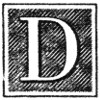
During the years immediately preceding the conflict on Lexington Green, the temper of the Colonials was sorely tested by persecutions instigated by Tyrant George III—“the Stamp Act, its repeal, with the declaration of the right to tax America; the landing of troops in Boston, beneath the batteries of fourteen vessels of war, lying broadside to the town, with springs on their cables, their guns loaded, and matches smoking; the repeated insults, and finally the massacre of the fifth of March resulting from this military occupation; and the Boston Port Bill, by which the final catastrophe was hurried on.” Delegates were appointed to the Continental Congress; at Salem the Provincial Congress was formed in October, 1774. At Concord and Cambridge the latter assembly enacted measures providing for troops, officers and stores. Early in the year 1775 it was clear that the crisis was at hand. General Gage betrayed his intentions when in March he caused the stone walls to be leveled that divided the fields about Boston, and so made these peaceful pastures ready for battle. His spies obtained information as to the amount of provisions hoarded at Concord and Worcester. On the fifteenth of April patriots in Boston were convinced that the plans of the British were mature, and an attack on Concord was imminent. By advice of Hancock and “Sam” Adams the stores were distributed among neighboring towns. Colonel Revere delivered his first warning, and “at length the momentous hour arrived, as big with consequences to Man as any that ever struck in his history.”
Though British officers were ignorant of the means by which Gage was to assail American freedom, the provincials already knew, and were prepared. The lanterns in North Church tower had signaled their message to watchers in Charlestown, and Revere and Dawes were already on their separate ways, when eight hundred grenadiers and light infantrymen landed at East Cambridge and crossed the marshland to the road that led to Lexington and Concord. At dawn the Minute Men were alive to the warning given by bells and drums that the enemy was approaching; three score or more answered the call to arms on Lexington Green—“a little band of farmers on their own training-field, facing the veteran ranks of the king.… Their homes, their property, personal and communal, and their rights as freemen were threatened; they were patriots and heroes, everyone.”
Commanded with threats and oaths to lay down his arms, Captain Parker of the militia cried to his men: “Don’t fire unless you are fired on; but if they want a war, let it begin here.” In the ensuing assault several militiamen fell, wounded to the death. The blood they spilled baptized the cause of Freedom in a new land. Resolved to die rather than submit, their martyrdom fixed the resolution of all their brothers in the Colonies.
Here, three-quarters of a century later, in “the birthplace of American liberty,” Louis Kossuth, the Hungarian patriot, eulogized “the embattled farmers” of immortal memory in these eloquent phrases: “It is their sacrificed blood in which is written the preface of your nation’s history. Their death was and ever will be the first bloody revelation of America’s destiny, and Lexington the opening scene of a revolution destined to change the character of human governments, and the condition of the human race.”
“The Minute Man of the Revolution!” exclaims George William Curtis. “And who was he? He was the husband and father, who left the plough in the furrow, the hammer on the bench, and, kissing wife and children, marched to die or be free!… This was the Minute Man of the Revolution! The rural citizen, trained in the common school, the town meeting, who carried a bayonet that thought, and whose gun, loaded with a principle, brought down, not a man, but a system!”
A youth who fought the king’s men that wonderful day described how they pushed the British back from Concord Bridge, back through Lincoln, Arlington, Cambridge and Somerville to the Charles. “What could be more pleasing to ambition,” he wrote, “than to knock off the shackles of despotism? Freedom was the hobby I mounted, sword in hand, neck or nothing, life or death. I will be one to support my country’s rights and gain its independence!”
“What was the matter, and what did you mean in going to the fight?” one of a later generation asked a veteran of Concord. “Young man,” was the reply, “what we meant in fighting was this: We always had been free, and we meant to be free always.”
PREPARED BY THE EDITORIAL STAFF OF THE MENTOR ASSOCIATION
ILLUSTRATION FOR THE MENTOR, VOL. 6, No. 10, SERIAL No. 158
COPYRIGHT, 1918, BY THE MENTOR ASSOCIATION, INC.
FROM THE PAINTING BY JOHN TRUMBULL. ORIGINAL IN THE CAPITOL, WASHINGTON, D. C.

SIGNING THE DECLARATION OF INDEPENDENCE
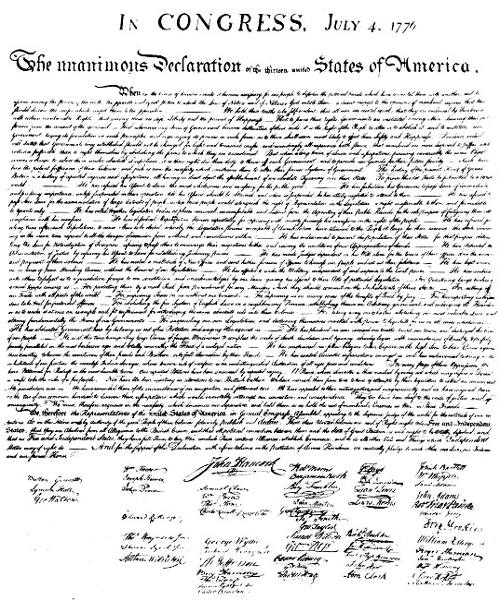
The Declaration of Independence is here reproduced in miniature—not for reading purposes; that would be too severe a tax on the eyesight—but simply to show the form and style of the historic Document. The original of this Document is preserved in the Department of State, Washington, carefully protected against light and air.
As may be seen, the Declaration bears the date July 4, 1776, and this is accepted as the Birthday of Independence. On July 3rd and 4th the Declaration was debated and the convention voted in favor of it, and authorized the presiding officer, John Hancock, and the secretary, Charles Thomson, to sign the Document. There was no single hour during which all signed. It was a matter of weeks. All came to it finally, for, as Benjamin Franklin shrewdly observed, “We must all hang together, or else we shall all hang separately.”
PREPARED BY THE EDITORIAL STAFF OF THE MENTOR ASSOCIATION
ILLUSTRATION FOR THE MENTOR, VOL. 6, No. 10, SERIAL No. 158
COPYRIGHT, 1918, BY THE MENTOR ASSOCIATION, INC.

IN INDEPENDENCE HALL, PHILADELPHIA, PA.
THE LIBERTY BELL
FIVE

The Philadelphians, having outgrown the primitive “Towne House” that had served the community’s needs since 1709, undertook in 1729 to erect an Assembly building commensurate with the growing importance of the province. A dozen years later the new State House was completed, including the dignified chamber now famous as the Hall in which the Declaration of Independence was discussed and received its first signatures. Another decade passed before sufficient funds were available for the rearing of a frame steeple on the south side of the building, “with a suitable place thereon for hanging a bell.” To grace this steeple and call together the Provincial Fathers, whose meeting-place was in one of the rooms below, it was decided after prolonged discussion that a bell be ordered from England. A letter dated November 1, 1751, was forthwith dispatched from the Superintendents of the State House to the Colonial agent in London, asking that he purchase “a good bell, of about two thousand pounds weight, the cost of which we may presume may amount to about one hundred pounds sterling, or, perhaps, with the charges, something more.… Let the bell be cast by the best workmen, and examined carefully before it is shipped, with the following words well shaped in large letters around it, viz:
‘By order of the Assembly of the Province of Pennsylvania, for the State House in the city of Philadelphia, 1752.’
And underneath,
‘Proclaim Liberty through all the land, to all the inhabitants thereof.—Levit. XXV. 10.’”
Within a year a ship bearing the new bell was reported at the water-front, and eager citizens thronged the pier hoping to see it. The arrival of the State House bell, destined none knew to what great mission, was the chief interest of that August day in Quaker Philadelphia. To the chagrin of the Superintendents they were compelled to announce a few days later that the long-looked-for bell had “cracked by a stroke of the clapper without any other violence, as it was hung up to try the sound.” Two “ingenious workmen” essayed to recast the metal, to which a larger proportion of copper had been added, and in April, 1753, artisans raised the “American bell” to its place in the steeple. Later on it was cast again, because the metal composition was now thought to contain too much copper. The result, we are told, was but tolerably successful. However, this “new great bell” continued in service for over sixty years. It announced the convening of the Assembly and the courts, and for a time was used to summon church-goers on Sunday.
The voice of the bell joined in joyful celebration with that of the people when the odious Stamp Act was repealed; late in the year 1773 it witnessed the agitated remonstrances of the inhabitants against the proposed importations of taxed tea. On September 5, 1774, the First Continental Congress convened in Carpenter’s Hall, Philadelphia. It convened again the following May in the State House, and paved the way to the Declaration of Independence. When the Battle of Lexington was reported on an April day, the State House bell summoned to the historic enclosure called the “Yard” a company of eight thousand people, determined to defend “with arms their lives, liberty and property, against all attempts to deprive them of them.”
Matters were hurrying to the breaking-point when in June, 1776, the State Assembly received the resolutions of the General Convention of Virginia, which forecast in sentiment and wording the final Declaration. Two days later the National Assembly, also in session at the State House, took the first step toward the Colonies’ Magna Charta when the resolution was read and seconded “That these United Colonies are, and of right ought to be, free and independent states.” A committee on the Declaration of Independence was chosen; July second the “Resolution respecting Independency” was confirmed by representatives of all the colonies except New York. For two days it was debated, on the evening of the fourth day of July it was passed, and the next day it was officially promulgated. On July eighth the Declaration of Independence was read from a balcony in the State House square, and the bell, which for a quarter of a century had awaited this moment to fulfill the prophecy of its Biblical quotation, proclaimed free and independent the Colonies of America.
The bell’s period of service was finally closed exactly forty-nine years after that day of rejoicing, when in tolling for the death of Chief Justice John Marshall its sides again cracked. It was then removed from the steeple, and now remains a monument in Independence Hall to the days when American Liberty was young.
PREPARED BY THE EDITORIAL STAFF OF THE MENTOR ASSOCIATION
ILLUSTRATION FOR THE MENTOR, VOL. 6, No. 10, SERIAL No. 158
COPYRIGHT, 1918, BY THE MENTOR ASSOCIATION, INC.

FROM A PHOTOGRAPH TAKEN IN INDEPENDENCE HALL.
CHILDREN OF LIBERTY
SIX
—William Cowper
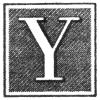
Youthful feet that wander through the classic halls of the old Pennsylvania State House (Independence Hall) pause longest before reminders of the first republic’s first president. To the children of Liberty, the name of Washington, “Freedom’s first and favorite son,” “the ideal type of civic virtue to succeeding generations,” sums up all the elements of patriotism. “Washington is the mightiest name on earth,” declared Abraham Lincoln, “long since mightiest in the cause of civil liberty, still mightiest in moral reformation.” Hear Daniel Webster: “The name of Washington is intimately blended with whatever belongs most essentially to the prosperity, the liberty, the free institutions, and the renown of our country.”
To the youth of the land this lustrous name is synonymous with Freedom, whose lessons they begin to learn in their primers. In the classroom, scholars receive instruction in loyalty to country, and initial training for their future obligations as citizens. The schools shelter the reserve forces of the nation, just as tender saplings are nurtured until the time when they will be uprooted and set in the open, to brave the winds that smite the forest. “Thy safeguard, Liberty, the school shall ever be.”
The inspirational sources of the country’s power, the mighty principles of its Constitution, are part of the teaching prescribed in American educational institutions. In recent years state legislatures have enacted laws providing for the display of the flag during school hours, for ceremonies that include a salute to Old Glory at the opening of each school day, for the observance of national holidays by special exercises, and for military instruction of public school pupils.
The promotion of patriotic study in the schools has, very appropriately, been fostered by bodies of Civil War veterans and allied organizations. Recognizing that “the training of citizens in the common knowledge and in the common duties of citizenship belongs irrevocably to the State,” wise leaders have consistently impressed upon the students under their care that a share in the safety of American freedom rests upon them. Programs comprising military drills, camp life, first aid, nursing, and the conservation of food supplies are in force, or contemplated, in many schools throughout the United States, such instruction frequently being under control of the Federal Government.
That patriotism is something more than a sentiment is the principle that modern school children are learning. In the United States there is a marked revival of interest in history, civics, and national traditions, and an accelerated curiosity among both native and foreign-born youth as to the circumstances that led to the founding of the Republic, and the patriots that sponsored its creation.
“The sheet-anchor of the Ship of State is the common school. Let no youth leave the school without being thoroughly grounded in the history, the principles, and the incalculable blessings of liberty. Let the boys be the trained soldiers of constitutional freedom, the girls the intelligent mothers of freemen.”
The accompanying gravure makes an especial appeal because of its simplicity. There is no posing in this group. The utter unconsciousness of the children, standing agaze before Washington’s portrait, is evidence enough of the deep-rooted feelings that hold them there in silent contemplation of the Father of their Country.
PREPARED BY THE EDITORIAL STAFF OF THE MENTOR ASSOCIATION
ILLUSTRATION FOR THE MENTOR, VOL. 6, No. 10, SERIAL No. 158
COPYRIGHT, 1918, BY THE MENTOR ASSOCIATION, INC.
THE MENTOR · · JULY 1, 1918
DEPARTMENT OF HISTORY
By ALBERT BUSHNELL HART
Professor of Government, Harvard University
MENTOR GRAVURES
FANEUIL HALL BOSTON, MASS.
OLD NORTH CHURCH BOSTON, MASS.
THE LINE OF THE MINUTE MEN LEXINGTON, MASS.
MENTOR GRAVURES
SIGNING THE DECLARATION OF INDEPENDENCE By John Trumbull
THE LIBERTY BELL
CHILDREN OF LIBERTY
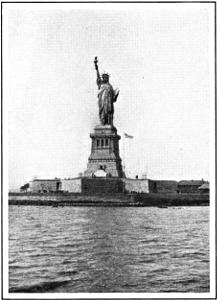
LIBERTY ENLIGHTENING THE WORLD
The Statue of Liberty is 151 feet high, standing on a granite pedestal 155 feet high. It was designed by the French sculptor, Frédéric Auguste Bartholdi. The cost, over a million francs, was subscribed by the people of France. The pedestal cost $250,000, raised by popular subscription in the United States. The statue was unveiled on October 28, 1886.
Entered as second-class matter March 10, 1913, at the postoffice at New York, N. Y., under the act of March 3, 1879. Copyright, 1918, by The Mentor Association, Inc.
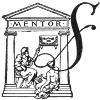
Singularly enough, the freest people on earth are not the happiest (using the word “free” in the broadest sense). The Esquimaux and the Australian “black fellows” know no hours of labor, no restriction on their movements, no courts to punish offences; yet, by all accounts, their lives are filled with danger, disease, and famine. Real liberty comes into being only when men feel the contact of freemen with freemen. Liberty flourishes where men are gathered into communities, because every man must accept some abridging of that perfect freedom which the lowest savages enjoy. The essence of liberty is to recognize other people’s liberty—and that means some restrictions all around; thus arises the system of balance and elastic government which we call democracy.
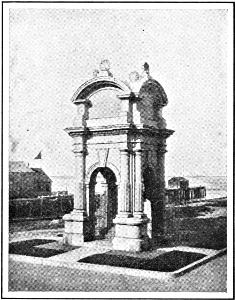
PLYMOUTH ROCK
The granite boulder enclosed by this memorial shrine is a fragment (broken off in 1774) of the large flat rock where the Pilgrims landed—which lies near the sea and is now covered by a wharf
Take an example of unlicensed liberty from the bumblebees, who have their own way, though unloved, while the honey-bees are citizens of a state, everyone going armed, as becomes a race renowned for its preparedness. The bees, however, are monarchists, who will fight and die for a sovereign queen whom they have never seen. So, at the opposite pole from the care-free, house-free—and often food-free savage, we may find a mass of individuals clustered in an empire, and obedient to the scepter or the nod of a personal sovereign.
Why do men with minds and wills accept personal sovereigns? Many times for safety. The beginning of kings is the soldier-chief, that “man on horseback,” who has been the destruction of commonwealths, and yet has founded many states,—first conqueror and then despot. As Daddy Smith said in the Massachusetts ratifying convention of 1788, in describing the social disturbances of Shays’ Rebellion, “Our distress was so great that we should have been glad to catch at anything that looked like a government for protection. Had any person that was able to protect us come and set up his standard, we should all have flocked to it, even if it had been a monarch, and that monarch might have proved a tyrant, so that you see that anarchy leads to tyranny, and better have one tyrant than so many at once.”
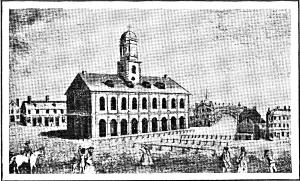
FANEUIL HALL IN 1789
The second Faneuil Hall. As rebuilt after the fire of 1761
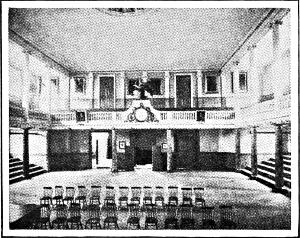
INTERIOR OF FANEUIL HALL
One would expect to find the cradle of liberty in the cradle of the civilized human race, that is in that once wealthy valley of Mesopotamia. Whatever the previous organization of family or tribe or clan, the earliest organized states of which we have a record were the mighty empires of Babylon and Assyria, the closest-knit monarchies of history, whose kings compared themselves with divinities and were worshiped as gods. What opportunity was there for the individual? The Great King lived in one world and all his subjects in another. The Assyrian sculptures tell how Sargon and Assurbanipal relieved the oppressed that ventured to strive for home rule! Shattered, pierced, impaled, these aspirants for liberty served to illustrate the absolute power of their masters. Yet despotism proved then, as it will in future prove, that when liberty is strangled, power departs; for all those vast empires fell before the armies of other invaders and conquerors.
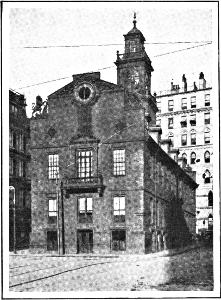
OLD STATE HOUSE, BOSTON, MASS.
Erected in 1748, and now under the guardianship of the Bostonian Society
Throughout later history the same effort has been made to corral human beings into a nation controlled over their heads by self-appointed rulers. Many dynasties began their power by seizing the citadel, destroying the freedom of their subjects, raising an army that should depend on them for pay and honors, and thus founding a lineage of sovereigns, who presently began to call themselves “Kings by the grace of God.” What mattered it that Dionysius, self-appointed Tyrant of Syracuse, built temples to the gods, offered splendid prizes for horse races, and rewarded sculptors? Did he not at the same time plunder and oppress his fellow-citizens, and murder his critics? With all his splendor he was a paltry adventurer, a thief, a usurper, a robber of liberty!
The spirit of the tyrant has infuriated thousands of chieftains, despots, princes, dukes, sultans, monarchs, sovereigns and emperors, all the way through history; and all the way there has been the counterbalancing force of men who would rather die than submit to an absolute master; men who did die to keep their families and friends and countrymen from bondage. The original cradle of liberty was in the hearts of free men and women, in the villages of the Slavs, among the turbulent Goths, in the republics of Greece and Rome, in the mountains, where it is easy for small groups to defend their own valleys and upland plateaus. Even in those communities part of the people often claimed superior privileges, and many free groups changed into the form that passed for liberty during medieval times, when a small top stratum of nobles and landowners claimed to be a master group, and trampled on the dependent races or men of their own race who furnished them with their daily bread.
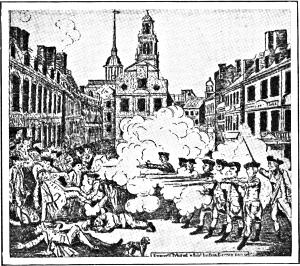
THE BOSTON MASSACRE, MARCH 5, 1770
The result of an encounter between a British sentry and the crowd
From the engraving by Paul Revere
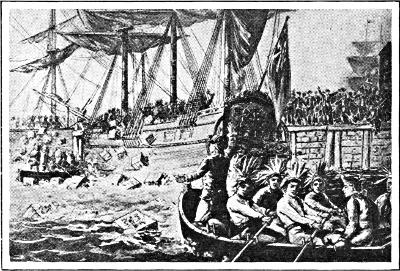
THE BOSTON TEA PARTY
From the fall of the Roman Empire to the French Revolution—a space of thirteen centuries—the only real republican governments were mountain peoples and independent trading cities, in which again the voting class was in small proportion. The only factors that ardently strove for liberty were the knights and noblemen, who did their best to weaken the power of the kings, so that they might have the more authority over their own vassals. The Middle Ages and even the period of the Restoration, with its appeal to the right to choose one’s own religion and to achieve one’s own salvation, did little to relieve the serf, the peasant, and the poor workman.
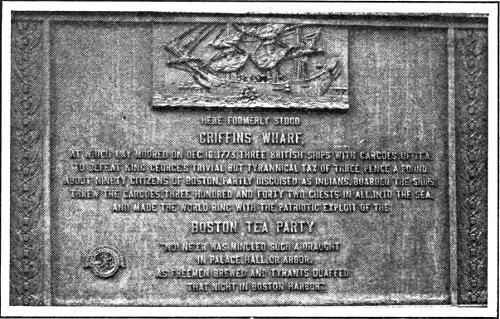
TABLET CELEBRATING THE BOSTON TEA PARTY
The inscription reads: “Here formerly stood Griffin’s wharf, at which lay moored on December 16, 1773, three British ships with cargoes of tea. To defeat King George’s trivial but tyrannical tax of three pence a pound, about ninety citizens of Boston, partly disguised as Indians, boarded the ships, threw the cargoes, three hundred and forty-two chests in all, into the sea, and made the world ring with the patriotic exploit of the Boston Tea Party.”
Against this gloomy background rose the wondrous structure of English liberty. At first the English people under their Norman kings were no freer than other peoples: England contained serfs and even slaves. The only people that had a share in the government were the Norman nobles who were sometimes consulted on the making of laws, and they were not different from the nobles that tried to divide power with the sovereigns of France and Sweden and the Germanic countries. The difference was that the dukes and counts and barons in most parts of Europe lost ground before the growth of an arbitrary royal power, while the English lords banded together successfully to secure pledges from their kings. In 1215 they wrung from King John the magnificent Magna Charta, including the glorious privileges that: “No freeman shall be taken or imprisoned, or disseised, or outlawed, or banished, or any way destroyed, nor will we pass upon him, nor will we send upon him, unless by the lawful judgment of his peers, or by the law of the land. We will sell to no man, we will not deny or delay to any man, either justice or right.”
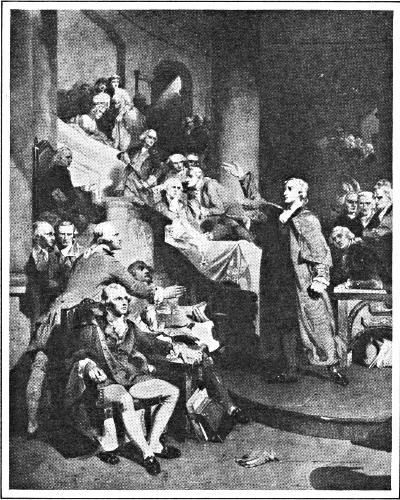
Original painting by Peter Frederick Rothermel (born 1817)
PATRICK HENRY ADDRESSING THE VIRGINIA ASSEMBLY IN 1765
Henry, supporting the resolutions to resist the Stamp Act, at one point exclaimed, “Caesar had his Brutus, Charles the First his Cromwell, and George the Third—” “Treason! treason!” shouted the Speaker of the Assembly. “Treason! treason!” shouted the members—“and,” Henry continued, “George the Third may profit by their example. If this be treason, make the most of it!”
Here we have at last a cradle of liberty; for the personal rights exacted by the nobles passed over to freemen, and in course of time all Englishmen became freemen. It was centuries before the kings at last gave way to the principle that the people through their representatives in Parliament ruled even the Crown; and in the process King Charles I lost his head, and King James II lost his throne. In the end, all the men and women of the realm were recognized as having the personal rights expressed in royal charters and acts of Parliament, which set them free from arbitrary taxes, arbitrary arrests, and arbitrary punishments.
They were entitled also to a tradition of common law, based on ideas of freedom, enforced for their benefit by independent courts and protected by trial by jury. Hence the England of the seventeenth century, from which the first colonists proceeded to North America, was that part of the globe in which law-abiding men and women had the largest opportunity of living their own lives, enjoying the fruits of their own labor, and dwelling under their own government.
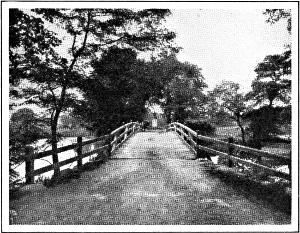
HISTORIC BRIDGE, CONCORD, MASS.
Showing battleground, and, across the bridge, the statue of the Minute Man by the sculptor, Daniel Chester French
Writers often speak of our present American system of government as founded upon the British practices of personal liberty and local self government and a free parliament. This is not accurate: Both our state and federal governments have borrowed little directly from the British parliamentary governing system. We have made our constitutions while Great Britain had none; we have organized a system of cabinet government, very different from that of parliamentary responsibility; we expanded our suffrage, and England slowly followed on that highway of liberty.
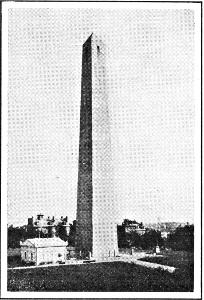
BUNKER HILL MONUMENT
Charlestown, Mass. A granite obelisk, 221 feet high, erected 1825-42 to commemorate the Battle of Bunker Hill, June 17, 1775
The truth is that the present government of Great Britain and the present government of the United States of America, with their personal liberties, both go back to a common source—the English government of the sixteenth and seventeenth centuries. It is a great mistake for us to think of Queen Elizabeth as a sovereign of a foreign country; or of the King James version of the Scriptures as something outside the United States; or of Shakespeare and Milton simply as “British poets.” We Americans have the same heritage in everything that was great and glorious in the British Isles, previous to colonization, as those that remained upon the soil, and in many respects we have made more improvement on those old models than our kin across the sea. The English had to struggle for nearly a century, from 1604 to 1688, against their kings, who wanted to turn the clock backward and take government out of the hands of the people. At that time the Colonies were very nearly independent little republics, who loved their English kings in proportion as those sovereigns kept their hands off. Except for the curse of negro slavery, which was allowed to get a firm grip on the body politic, the Colonies down to Revolutionary times were freer, happier and more prosperous than the mother country, and that was the main reason for the Revolution. Why should people who were doing so well in managing themselves continue in the leading strings of a government that saved its democracy in England for the higher classes?
The Colonies were not little political heavens. Their ideas of liberty did not extend to Indians, or Negroes, or Quakers. Nevertheless, in the main, they stood stoutly for freedom of person, freedom of judicial trial, freedom of legislative bodies; and they were about half a century earlier than England in establishing (in the famous Zenger case of 1734) the priceless right publicly to criticize their own governments. John Wise, who was one of them, had a right to say that they “hate an arbitrary power (politically considered) as they hate the devil.”
The first written constitution in history that was adopted by a people and that also organized a government, “The Fundamental Orders of Connecticut,” was drawn up in 1639 by freemen of Windsor, Hartford and Wethersfield. Under this law the people of Connecticut lived for nearly two centuries. The twelve articles it comprised expressed “pure democracy acting through representation, and imposing organic limitations.”
“Here is the first practical assertion of the right of the people, not only to choose, but to limit the powers of their rulers—an assertion that lies at the foundation of the American system. It is on the banks of the Connecticut, under the mighty preaching of Thomas Hooker, and in the constitution to which he gave life, if not form, that we draw the first breath of that atmosphere which is now so familiar to us. The birthplace of American Democracy is Hartford.”
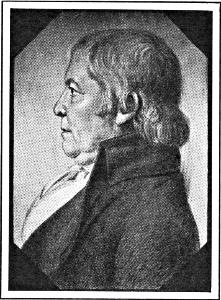
PAUL REVERE
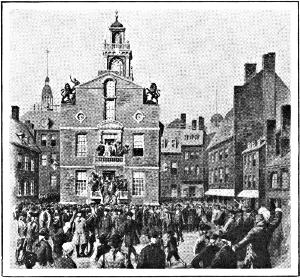
READING THE DECLARATION OF INDEPENDENCE FROM THE STATE HOUSE, BOSTON
By common consent, the period when these principles of liberty of person and of government were first clearly impressed on the world was in the American Revolution, which deserves to be called the cradle of modern liberty. When things grew squally in the Colonies, our forefathers insisted that their brand of liberty was better than the British kind, and they began to draw up lists of rights and grievances, especially in the Stamp Act Congress of 1765. The new states of the American Union, as they were organized, bound themselves to observe Bills of Rights containing such stirring principles as that, “All power is vested in, and consequently derived from, the people.” “All elections ought to be free, and that all men having sufficient evidence of permanent interest with, and attached to the community, have the right of suffrage.”—“The freedom of the press is one of the great bulwarks of liberty.”—“All men are equally entitled to the free exercise of religion, according to the dictates of conscience.”
By far the most renowned statement of the noble rights of liberty was the Declaration of Independence. At the time, people were most interested in the classified indictment of the king of Great Britain for interfering with American liberty. The world, however, has long agreed that the big memorable, permanent thing in that Declaration is found in the three magnificent sentences that fulfill the injunction of the Liberty Bell, to “proclaim liberty throughout all the land, to all the inhabitants thereof.” Those imperishable sentences are: “We hold these truths to be self-evident, that all men are created equal, that they are endowed by their Creator with certain unalienable Rights, that among these are Life, Liberty and the pursuit of Happiness,—That to secure these rights, Governments are instituted among Men, deriving their just powers from the consent of the governed,—That whenever any form of Government becomes destructive of these ends, it is the Right of the People to alter or to abolish it, and to institute new Government, laying its foundation on such principles and organizing its powers in such form, as to them shall seem most likely to effect their Safety and Happiness.”
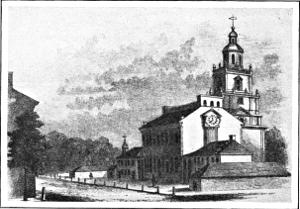
ORIGINAL INDEPENDENCE HALL
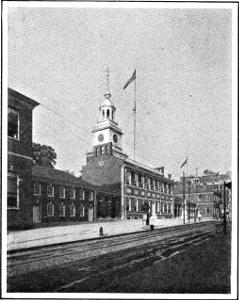
INDEPENDENCE HALL TODAY
Chestnut Street front
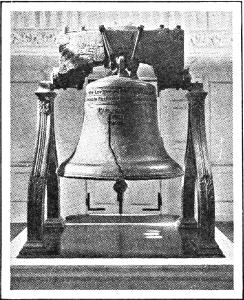
THE LIBERTY BELL
After all, anyone who can think like Franklin and write like Jefferson could draw up a Declaration of Independence; but somebody had to fight like Washington, in order to demonstrate that a democratic country, resting on principles of liberty, could (with never-to-be-forgotten aid from the French) achieve its own freedom. The lesson of liberty was deeply learned in France, where the early French Revolution of 1789 basked in the sunshine of American freedom.
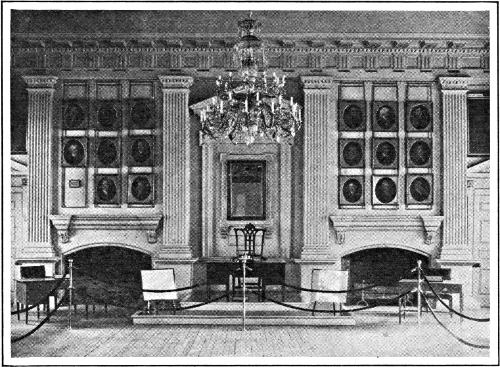
INTERIOR OF INDEPENDENCE HALL
Room in which Independence was born into a definite Declaration—showing table at which Hancock placed his signature on the historic Document
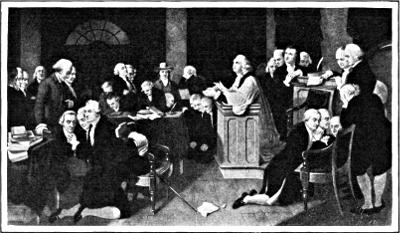
From original painting by T. H. Matteson.
FIRST PRAYER IN CONGRESS—CARPENTER’S HALL, PHILADELPHIA
Frenchmen read the Declaration of Independence, and framed a “Declaration of the Rights of Man and the Citizen.” They adopted for their watchword the three words, “Liberté, Egalité, Fraternité,” which are inscribed on the public buildings of the present French Republic. Liberty—that is, personal freedom; equality—that is, equal rights before the law; fraternity—that is, brotherhood with other people. The French, like the Americans, made it their bottom principle that freedom was the normal condition of men, and that everybody was entitled to a chance to do what in him lay, provided he did not thereby obstruct the equal privileges of his brother man. With many hesitations, and some errors, the rising nations of the nineteenth century strove to make real those glorious ideas. The Latin peoples of both North and South America all professed liberty. Republics have been set up in Switzerland, in France, in Portugal, in China, in Russia. Virtual democracies are established in the Scandinavian countries, Holland, Italy, Great Britain, and the great British commonwealths of Canada, Australia, New Zealand and South Africa. Even Germany, Austria-Hungary, Bulgaria and Turkey use the forms of popular government to conceal the real refusal of responsibility to the people by their sovereigns.
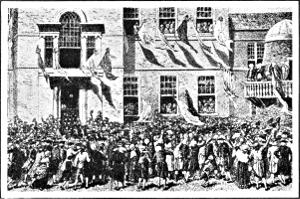
ANNOUNCEMENT OF THE DECLARATION OF INDEPENDENCE to the assembled crowd outside Independence Hall, Philadelphia, July 8, 1776
After the Revolution came the real test of the whole principle. How could one generation, nurtured in the cradle of liberty, pass that blessing on to its descendants? The solution was found in a system of state and national constitutions wherein, while standing by the inalienable right of men to alter their government as they saw need, checks and limitations were introduced for the protection of personal rights. All the state constitutions, and eventually the new federal constitution, included statements of those precious privileges. The share in the government, so necessary for keeping alive an interest in the welfare of the state, was extended more and more widely, till in our time it seems likely to include all legally competent men and women. As time has passed, new personal relations have developed; slavery has been rooted out, the rights of labor have come to the front and women have the vote. In time of war personal rights must yield something to the necessities of the state, but they are the bedrock of American Government.
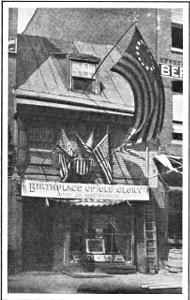
THE BIRTHPLACE OF OLD GLORY
The Betsy Ross House, on Arch Street, Philadelphia, where the first American flag was made
What is this liberty for which the statesman labors and the soldier gives his life? How comes it that the United States of America is the cradle of the principle, and that the success of this great republic is the admiration of mankind? The sages and patriots of Revolutionary times strove to explain and define it without much success. Edmund Burke, the friend of the Colonies, found six “capital sources” from which “a fierce spirit of liberty has grown up.” Most of these have long ceased to operate, yet the spirit of liberty is still fierce. We all understand that liberty means personal freedom, liberty to express one’s thoughts in speech and press and religious observance; the right to be tried by impartial public courts, including a jury; the right to a government founded on the expression of the will of the people, through votes; the right to change a government that has ceased to meet the needs of the people; the right to education; an opportunity to test one’s powers;—especially the right to take the voice of the many, instead of a few, on the great questions of national life.
Liberty, however, is more than a kind of government, or a rule of action; it is a political religion, a worship, an inspiration. Statesmen strove to express it in terms of reverence and affection. Thus the Continental Congress sounded its trumpet call:
“Honour, Justice, and Humanity forbid us to surrender that freedom which we received from our ancestors, and which our posterity have a right to receive from us.”
A great poet, Emerson, later sought to set forth this passionate devotion to liberty: “What the tender poetic youth dreams, and prays, and paints today, but shuns the ridicule of saying aloud, shall presently be the resolutions of public bodies, then shall be carried as a grievance and bill of rights through conflict and war, and then shall be triumphant law and establishment for a hundred years, until it gives place, in turn, to new prayers and pictures.” So all the ideals of Liberty, like seed in the souls of mankind, take root and bear fruit in good time.
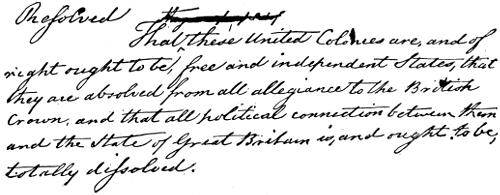
FAC-SIMILE OF THE ORIGINAL RESOLUTION AS OFFERED BY MR. RICHARD HENRY LEE
THE INITIATION OF INDEPENDENCE.
THE STORY OF LIBERTY, as developed in 500 years of history. Illustrated. By C. C. Coffin
INDEPENDENCE DAY. A collection of prose and verse. Edited by R. H. Schauffler
⁂ Information concerning the above books may be had on application to the Editor of The Mentor.
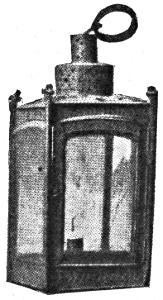
ONE OF THE LANTERNS THAT HUNG IN THE BELFRY OF OLD NORTH CHURCH
Now in the possession of the Concord Antiquarian Society
Man was free to begin with—as free as the beasts of the earth and the birds of the air. Who, then enslaved humanity? Man himself. So when Man seeks liberty, he seeks to free himself from conditions that he has imposed on his own kind—to free himself from “Man’s inhumanity to Man.” It is Desire—selfish Desire for conquest, possession and control—that has enslaved mankind. The man that seeks liberty, then, should have no place in his breast for greed and selfish desire. If, underneath his feelings of revolt against the Tyrant and the Master, there burns in his own soul the flame of selfish desire, how can he condemn those that aspire to be masters of the world? How would he himself use supreme power if it were his? Would he dominate others with an iron hand, or would he lend his strength to the weak? When a man has answered that question to his own satisfaction, knowing in his soul that he has been truthful with himself, he may justly claim to be a lover of liberty.
Carlyle pictured humanity in the mass as an “Egyptian urn filled with tamed vipers, each one struggling to raise its head above the others.” That is a bitter expression of life’s struggle—but in the light of history not an exaggerated one. That kind of struggle does not make for liberty. That is a struggle for supremacy. Until the desire for supremacy—for conquest and control, be checked in the human soul, that bitter struggle will go on. Don’t mistake the meaning of the cry for liberty. Liberty does not mean freedom from subjection for us that we may master others. It means freedom for all men—everywhere—always. The love of liberty implies the love of humanity—the spirit of true democracy.
Some years ago I heard a great leader of our people define democracy. “We observe,” he said, “a young man of high social standing making a companion of his washerwoman’s son, and we call him democratic. Is he really so? Perhaps the washerwoman’s son possesses qualities that would command the attention and respect of every one; perhaps he has tastes in common with the young man. That is not democracy. That is natural selection—like seeking like. It is very easy for a man to be democratic with people he likes. But that is not democracy. True democracy is that spirit in a man which makes the welfare of his fellow men a thing vital to him, whether he likes them or not.”
So it is with the spirit of liberty. It is all inclusive, without taint of selfishness. It does not mean that I shall be free to do what I choose. It means that I consider it vital that all men shall be free and that all shall enjoy life, liberty and the pursuit of happiness, with due consideration for the rights and privileges of every one. The spirit found expression in the words of George Washington, when, after leading the six-year struggle of America for liberty he was urged by his officers to assume imperial authority. Indignantly rebuking his officers for an idea that he “viewed with abhorrence,” he said, in effect, “Let no man ever offer that to me.”
Today the United States is engaged in the greatest conflict in all history—not for conquest and mastery, not for territory nor advantages in commerce, not for any material gain whatever, but for the simple cause of liberty. As a national cause, liberty was first established by the United States. When America determined on its freedom in 1776, the recording hand of Fate wrote on the pages of History, where the eyes of all kings might read, “Mene, mene, tekel, upharsin.” “You have been tried in the balance and found wanting.” The passing years have confirmed the judgment. The Divine Right of Kings is under sentence. The day of reckoning is at hand.

W. D. Moffat
Editor
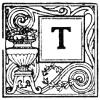
There are many popular misconceptions concerning the incidents attending the birth of American Liberty and the Proclamation of Independence. Erroneous traditions gained credence in the early days, and romanticists and poets have perpetuated them through successive generations. It is important, therefore, to note the facts as given by historical scholars who have made a careful study of original records, and whose evidence may, in consequence, be relied upon.
The Fourth of July is observed as the Birthday of Independence. This is the date the Document bears. The events leading up to the adoption of the Declaration are recounted in Monograph Five in this number of The Mentor. Subsequent events were as follows: On July fifth Congress authorized the official promulgation of Independence, ordering that broadsides, signed by John Hancock and Charles Thomson, the President and Secretary of Congress, be sent to the several assemblies, the army, and other colonial bodies, and “that it be proclaimed in each of the United States.” On July sixth it was ordered “that the Sheriff read or cause to be read and proclaimed at the State House, Philadelphia, on Monday, the eighth of July, instant at 12 o’clock noon, the Declaration of the Representatives of the United States of America.” July 8, 1776, broke “a warm, sunshiny morning.” Officers, constables, members of committees and the people at large assembled in the State House Yard, and there amidst the waving of flags and the fluttering of banners, the Declaration was read by John Nixon “in a voice clear and distinct,” and greeted with loud cheers.
This was the first time the Declaration was read in public. The stories of the bright-eyed boy, and immense crowds storming the doors of Congress on July fourth, and of the Declaration being read on that day from the steps are pronounced “pure inventions” by historical authorities. We have the record, also, that on the eighth of July, “near the hour of twelve,” the bell was first rung for the Proclamation of the Declaration.
John Adams designated the second of July, on which day the Resolution of Independence was confirmed by the Representatives, as the anniversary that should, in future years, be celebrated by bells, fireworks and cannon. On July fourth the Declaration was adopted, and the document was authenticated by the signatures of the President and Secretary and all the members present, except Mr. Dickinson of Pennsylvania. Several days later the Declaration was engrossed on parchment and, on the second of August, the first signatures were affixed; the other signatures followed later. This is the Declaration that has been preserved as the original, the first signed paper having probably been destroyed. “If,” as one writer puts it, “the natal day of American Independence is to be derived from the ceremony of the signing, and the real date of what has been preserved as the original of the Declaration, then it would be the second of August. If derived from the substantial, legal act of separation from the British Crown, it would be the second of July. But common consent has determined the date of the great anniversary from the apparently subordinate event of the passage of the Declaration, and thus we celebrate the Fourth of July as the birthday of the nation.”
The Mentor Association
ESTABLISHED FOR THE DEVELOPMENT OF POPULAR INTEREST IN ART, LITERATURE, SCIENCE, HISTORY, NATURE AND TRAVEL
THE MENTOR IS PUBLISHED TWICE A MONTH
BY THE MENTOR ASSOCIATION, INC., AT 114-116 EAST 16TH STREET, NEW YORK, N. Y. SUBSCRIPTION, FOUR DOLLARS A YEAR. FOREIGN POSTAGE 75 CENTS EXTRA. CANADIAN POSTAGE 50 CENTS EXTRA. SINGLE COPIES TWENTY CENTS. PRESIDENT, THOMAS H. BECK; VICE-PRESIDENT, WALTER P. TEN EYCK; SECRETARY, W. D. MOFFAT; TREASURER, J. S. CAMPBELL; ASSISTANT TREASURER AND ASSISTANT SECRETARY, H. A. CROWE.
THE MENTOR
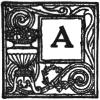
A century ago War had left the heart of Europe torn and bleeding. Napoleon was ambitious to conquer the earth—a fitting parallel today is another who wishes a place in the sun! Are you familiar with the points of similarity in the ambitions of these two imperial disturbers of the peace of the world? Do you know about the meteoric career of the great Napoleon—with its equally meteoric ending? There is another story that has a fascination that will endure forever—the story of Jeanne d’Arc, one of the most remarkable women of all time, who at thirteen years of age was inspired to lead the armies of France to victory.
But we need not go outside of the United States to find examples of heroism and valor that make the pages of history glow with interest. There were the farmers of Lexington who, in 1775, fired “the shot heard round the world”—a shot that gave Americans a great country in which to enjoy life, liberty and the pursuit of happiness. And we cannot forget Paul Jones, who, when his little ship was about to sink, answered the commander of the great Serapis, who invited him to surrender, with the immortal words, “I have not yet begun to fight!” It is of special interest, in the light of present-day happenings, to recall such patriots as Henry Clay, who, when asked the question in 1812, “What are we to gain by war?” replied, “What are we not to lose by peace—commerce, character, a nation’s best treasure, honor?” There is the spirit of true patriotism for you!
Get acquainted with the great men and the great deeds of the past, for that is the only way to understand and appreciate the men and deeds of the present. Lay a firm foundation for your understanding of the World War by studying previous great wars, warriors and statesmen of the world. To know history, however, it is no longer necessary to spend long hours poring over musty volumes of closely-printed facts—unsifted facts, with the vitally interesting ones often buried so deep in wearisome details that it is slow work finding them!
The Mentor History Set has been made up by such authoritative writers as Albert Bushnell Hart, Ida M. Tarbell, and George Willis Botsford. It gives you in compact form the very information you should have to obtain a concise knowledge of history past and present, besides over four hundred unusual half-tones, and one hundred and twenty beautiful full-page gravures printed in sepia tone.
THESE ARE SOME OF THE SUBJECTS COVERED IN THIS GREAT HISTORY SET
HAVE THESE NUMBERS SENT ON APPROVAL
Just put your name and address on a postal, stating that you wish to have the History Set. The twenty-three numbers will then be sent you, all charges paid. You may send us seventy cents within ten days, and only a dollar a month for four months, if you prefer, or you may pay four dollars and fifty cents cash on acceptance.
THE MENTOR ASSOCIATION, Inc.
114-116 East 16th Street New York City
MAKE THE SPARE
MOMENT COUNT

End of the Project Gutenberg EBook of The Mentor: The Cradle of Liberty,
Vol. 6, Num. 10, Serial No. 158, J, by Albert Bushnell Hart
*** END OF THIS PROJECT GUTENBERG EBOOK THE MENTOR: THE CRADLE OF LIBERTY ***
***** This file should be named 51556-h.htm or 51556-h.zip *****
This and all associated files of various formats will be found in:
http://www.gutenberg.org/5/1/5/5/51556/
Produced by Juliet Sutherland and the Online Distributed
Proofreading Team at http://www.pgdp.net
Updated editions will replace the previous one--the old editions
will be renamed.
Creating the works from public domain print editions means that no
one owns a United States copyright in these works, so the Foundation
(and you!) can copy and distribute it in the United States without
permission and without paying copyright royalties. Special rules,
set forth in the General Terms of Use part of this license, apply to
copying and distributing Project Gutenberg-tm electronic works to
protect the PROJECT GUTENBERG-tm concept and trademark. Project
Gutenberg is a registered trademark, and may not be used if you
charge for the eBooks, unless you receive specific permission. If you
do not charge anything for copies of this eBook, complying with the
rules is very easy. You may use this eBook for nearly any purpose
such as creation of derivative works, reports, performances and
research. They may be modified and printed and given away--you may do
practically ANYTHING with public domain eBooks. Redistribution is
subject to the trademark license, especially commercial
redistribution.
*** START: FULL LICENSE ***
THE FULL PROJECT GUTENBERG LICENSE
PLEASE READ THIS BEFORE YOU DISTRIBUTE OR USE THIS WORK
To protect the Project Gutenberg-tm mission of promoting the free
distribution of electronic works, by using or distributing this work
(or any other work associated in any way with the phrase "Project
Gutenberg"), you agree to comply with all the terms of the Full Project
Gutenberg-tm License (available with this file or online at
http://gutenberg.org/license).
Section 1. General Terms of Use and Redistributing Project Gutenberg-tm
electronic works
1.A. By reading or using any part of this Project Gutenberg-tm
electronic work, you indicate that you have read, understand, agree to
and accept all the terms of this license and intellectual property
(trademark/copyright) agreement. If you do not agree to abide by all
the terms of this agreement, you must cease using and return or destroy
all copies of Project Gutenberg-tm electronic works in your possession.
If you paid a fee for obtaining a copy of or access to a Project
Gutenberg-tm electronic work and you do not agree to be bound by the
terms of this agreement, you may obtain a refund from the person or
entity to whom you paid the fee as set forth in paragraph 1.E.8.
1.B. "Project Gutenberg" is a registered trademark. It may only be
used on or associated in any way with an electronic work by people who
agree to be bound by the terms of this agreement. There are a few
things that you can do with most Project Gutenberg-tm electronic works
even without complying with the full terms of this agreement. See
paragraph 1.C below. There are a lot of things you can do with Project
Gutenberg-tm electronic works if you follow the terms of this agreement
and help preserve free future access to Project Gutenberg-tm electronic
works. See paragraph 1.E below.
1.C. The Project Gutenberg Literary Archive Foundation ("the Foundation"
or PGLAF), owns a compilation copyright in the collection of Project
Gutenberg-tm electronic works. Nearly all the individual works in the
collection are in the public domain in the United States. If an
individual work is in the public domain in the United States and you are
located in the United States, we do not claim a right to prevent you from
copying, distributing, performing, displaying or creating derivative
works based on the work as long as all references to Project Gutenberg
are removed. Of course, we hope that you will support the Project
Gutenberg-tm mission of promoting free access to electronic works by
freely sharing Project Gutenberg-tm works in compliance with the terms of
this agreement for keeping the Project Gutenberg-tm name associated with
the work. You can easily comply with the terms of this agreement by
keeping this work in the same format with its attached full Project
Gutenberg-tm License when you share it without charge with others.
1.D. The copyright laws of the place where you are located also govern
what you can do with this work. Copyright laws in most countries are in
a constant state of change. If you are outside the United States, check
the laws of your country in addition to the terms of this agreement
before downloading, copying, displaying, performing, distributing or
creating derivative works based on this work or any other Project
Gutenberg-tm work. The Foundation makes no representations concerning
the copyright status of any work in any country outside the United
States.
1.E. Unless you have removed all references to Project Gutenberg:
1.E.1. The following sentence, with active links to, or other immediate
access to, the full Project Gutenberg-tm License must appear prominently
whenever any copy of a Project Gutenberg-tm work (any work on which the
phrase "Project Gutenberg" appears, or with which the phrase "Project
Gutenberg" is associated) is accessed, displayed, performed, viewed,
copied or distributed:
This eBook is for the use of anyone anywhere at no cost and with
almost no restrictions whatsoever. You may copy it, give it away or
re-use it under the terms of the Project Gutenberg License included
with this eBook or online at www.gutenberg.org/license
1.E.2. If an individual Project Gutenberg-tm electronic work is derived
from the public domain (does not contain a notice indicating that it is
posted with permission of the copyright holder), the work can be copied
and distributed to anyone in the United States without paying any fees
or charges. If you are redistributing or providing access to a work
with the phrase "Project Gutenberg" associated with or appearing on the
work, you must comply either with the requirements of paragraphs 1.E.1
through 1.E.7 or obtain permission for the use of the work and the
Project Gutenberg-tm trademark as set forth in paragraphs 1.E.8 or
1.E.9.
1.E.3. If an individual Project Gutenberg-tm electronic work is posted
with the permission of the copyright holder, your use and distribution
must comply with both paragraphs 1.E.1 through 1.E.7 and any additional
terms imposed by the copyright holder. Additional terms will be linked
to the Project Gutenberg-tm License for all works posted with the
permission of the copyright holder found at the beginning of this work.
1.E.4. Do not unlink or detach or remove the full Project Gutenberg-tm
License terms from this work, or any files containing a part of this
work or any other work associated with Project Gutenberg-tm.
1.E.5. Do not copy, display, perform, distribute or redistribute this
electronic work, or any part of this electronic work, without
prominently displaying the sentence set forth in paragraph 1.E.1 with
active links or immediate access to the full terms of the Project
Gutenberg-tm License.
1.E.6. You may convert to and distribute this work in any binary,
compressed, marked up, nonproprietary or proprietary form, including any
word processing or hypertext form. However, if you provide access to or
distribute copies of a Project Gutenberg-tm work in a format other than
"Plain Vanilla ASCII" or other format used in the official version
posted on the official Project Gutenberg-tm web site (www.gutenberg.org),
you must, at no additional cost, fee or expense to the user, provide a
copy, a means of exporting a copy, or a means of obtaining a copy upon
request, of the work in its original "Plain Vanilla ASCII" or other
form. Any alternate format must include the full Project Gutenberg-tm
License as specified in paragraph 1.E.1.
1.E.7. Do not charge a fee for access to, viewing, displaying,
performing, copying or distributing any Project Gutenberg-tm works
unless you comply with paragraph 1.E.8 or 1.E.9.
1.E.8. You may charge a reasonable fee for copies of or providing
access to or distributing Project Gutenberg-tm electronic works provided
that
- You pay a royalty fee of 20% of the gross profits you derive from
the use of Project Gutenberg-tm works calculated using the method
you already use to calculate your applicable taxes. The fee is
owed to the owner of the Project Gutenberg-tm trademark, but he
has agreed to donate royalties under this paragraph to the
Project Gutenberg Literary Archive Foundation. Royalty payments
must be paid within 60 days following each date on which you
prepare (or are legally required to prepare) your periodic tax
returns. Royalty payments should be clearly marked as such and
sent to the Project Gutenberg Literary Archive Foundation at the
address specified in Section 4, "Information about donations to
the Project Gutenberg Literary Archive Foundation."
- You provide a full refund of any money paid by a user who notifies
you in writing (or by e-mail) within 30 days of receipt that s/he
does not agree to the terms of the full Project Gutenberg-tm
License. You must require such a user to return or
destroy all copies of the works possessed in a physical medium
and discontinue all use of and all access to other copies of
Project Gutenberg-tm works.
- You provide, in accordance with paragraph 1.F.3, a full refund of any
money paid for a work or a replacement copy, if a defect in the
electronic work is discovered and reported to you within 90 days
of receipt of the work.
- You comply with all other terms of this agreement for free
distribution of Project Gutenberg-tm works.
1.E.9. If you wish to charge a fee or distribute a Project Gutenberg-tm
electronic work or group of works on different terms than are set
forth in this agreement, you must obtain permission in writing from
both the Project Gutenberg Literary Archive Foundation and Michael
Hart, the owner of the Project Gutenberg-tm trademark. Contact the
Foundation as set forth in Section 3 below.
1.F.
1.F.1. Project Gutenberg volunteers and employees expend considerable
effort to identify, do copyright research on, transcribe and proofread
public domain works in creating the Project Gutenberg-tm
collection. Despite these efforts, Project Gutenberg-tm electronic
works, and the medium on which they may be stored, may contain
"Defects," such as, but not limited to, incomplete, inaccurate or
corrupt data, transcription errors, a copyright or other intellectual
property infringement, a defective or damaged disk or other medium, a
computer virus, or computer codes that damage or cannot be read by
your equipment.
1.F.2. LIMITED WARRANTY, DISCLAIMER OF DAMAGES - Except for the "Right
of Replacement or Refund" described in paragraph 1.F.3, the Project
Gutenberg Literary Archive Foundation, the owner of the Project
Gutenberg-tm trademark, and any other party distributing a Project
Gutenberg-tm electronic work under this agreement, disclaim all
liability to you for damages, costs and expenses, including legal
fees. YOU AGREE THAT YOU HAVE NO REMEDIES FOR NEGLIGENCE, STRICT
LIABILITY, BREACH OF WARRANTY OR BREACH OF CONTRACT EXCEPT THOSE
PROVIDED IN PARAGRAPH 1.F.3. YOU AGREE THAT THE FOUNDATION, THE
TRADEMARK OWNER, AND ANY DISTRIBUTOR UNDER THIS AGREEMENT WILL NOT BE
LIABLE TO YOU FOR ACTUAL, DIRECT, INDIRECT, CONSEQUENTIAL, PUNITIVE OR
INCIDENTAL DAMAGES EVEN IF YOU GIVE NOTICE OF THE POSSIBILITY OF SUCH
DAMAGE.
1.F.3. LIMITED RIGHT OF REPLACEMENT OR REFUND - If you discover a
defect in this electronic work within 90 days of receiving it, you can
receive a refund of the money (if any) you paid for it by sending a
written explanation to the person you received the work from. If you
received the work on a physical medium, you must return the medium with
your written explanation. The person or entity that provided you with
the defective work may elect to provide a replacement copy in lieu of a
refund. If you received the work electronically, the person or entity
providing it to you may choose to give you a second opportunity to
receive the work electronically in lieu of a refund. If the second copy
is also defective, you may demand a refund in writing without further
opportunities to fix the problem.
1.F.4. Except for the limited right of replacement or refund set forth
in paragraph 1.F.3, this work is provided to you 'AS-IS' WITH NO OTHER
WARRANTIES OF ANY KIND, EXPRESS OR IMPLIED, INCLUDING BUT NOT LIMITED TO
WARRANTIES OF MERCHANTABILITY OR FITNESS FOR ANY PURPOSE.
1.F.5. Some states do not allow disclaimers of certain implied
warranties or the exclusion or limitation of certain types of damages.
If any disclaimer or limitation set forth in this agreement violates the
law of the state applicable to this agreement, the agreement shall be
interpreted to make the maximum disclaimer or limitation permitted by
the applicable state law. The invalidity or unenforceability of any
provision of this agreement shall not void the remaining provisions.
1.F.6. INDEMNITY - You agree to indemnify and hold the Foundation, the
trademark owner, any agent or employee of the Foundation, anyone
providing copies of Project Gutenberg-tm electronic works in accordance
with this agreement, and any volunteers associated with the production,
promotion and distribution of Project Gutenberg-tm electronic works,
harmless from all liability, costs and expenses, including legal fees,
that arise directly or indirectly from any of the following which you do
or cause to occur: (a) distribution of this or any Project Gutenberg-tm
work, (b) alteration, modification, or additions or deletions to any
Project Gutenberg-tm work, and (c) any Defect you cause.
Section 2. Information about the Mission of Project Gutenberg-tm
Project Gutenberg-tm is synonymous with the free distribution of
electronic works in formats readable by the widest variety of computers
including obsolete, old, middle-aged and new computers. It exists
because of the efforts of hundreds of volunteers and donations from
people in all walks of life.
Volunteers and financial support to provide volunteers with the
assistance they need, are critical to reaching Project Gutenberg-tm's
goals and ensuring that the Project Gutenberg-tm collection will
remain freely available for generations to come. In 2001, the Project
Gutenberg Literary Archive Foundation was created to provide a secure
and permanent future for Project Gutenberg-tm and future generations.
To learn more about the Project Gutenberg Literary Archive Foundation
and how your efforts and donations can help, see Sections 3 and 4
and the Foundation web page at http://www.pglaf.org.
Section 3. Information about the Project Gutenberg Literary Archive
Foundation
The Project Gutenberg Literary Archive Foundation is a non profit
501(c)(3) educational corporation organized under the laws of the
state of Mississippi and granted tax exempt status by the Internal
Revenue Service. The Foundation's EIN or federal tax identification
number is 64-6221541. Its 501(c)(3) letter is posted at
http://pglaf.org/fundraising. Contributions to the Project Gutenberg
Literary Archive Foundation are tax deductible to the full extent
permitted by U.S. federal laws and your state's laws.
The Foundation's principal office is located at 4557 Melan Dr. S.
Fairbanks, AK, 99712., but its volunteers and employees are scattered
throughout numerous locations. Its business office is located at
809 North 1500 West, Salt Lake City, UT 84116, (801) 596-1887, email
business@pglaf.org. Email contact links and up to date contact
information can be found at the Foundation's web site and official
page at http://pglaf.org
For additional contact information:
Dr. Gregory B. Newby
Chief Executive and Director
gbnewby@pglaf.org
Section 4. Information about Donations to the Project Gutenberg
Literary Archive Foundation
Project Gutenberg-tm depends upon and cannot survive without wide
spread public support and donations to carry out its mission of
increasing the number of public domain and licensed works that can be
freely distributed in machine readable form accessible by the widest
array of equipment including outdated equipment. Many small donations
($1 to $5,000) are particularly important to maintaining tax exempt
status with the IRS.
The Foundation is committed to complying with the laws regulating
charities and charitable donations in all 50 states of the United
States. Compliance requirements are not uniform and it takes a
considerable effort, much paperwork and many fees to meet and keep up
with these requirements. We do not solicit donations in locations
where we have not received written confirmation of compliance. To
SEND DONATIONS or determine the status of compliance for any
particular state visit http://pglaf.org
While we cannot and do not solicit contributions from states where we
have not met the solicitation requirements, we know of no prohibition
against accepting unsolicited donations from donors in such states who
approach us with offers to donate.
International donations are gratefully accepted, but we cannot make
any statements concerning tax treatment of donations received from
outside the United States. U.S. laws alone swamp our small staff.
Please check the Project Gutenberg Web pages for current donation
methods and addresses. Donations are accepted in a number of other
ways including checks, online payments and credit card donations.
To donate, please visit: http://pglaf.org/donate
Section 5. General Information About Project Gutenberg-tm electronic
works.
Professor Michael S. Hart is the originator of the Project Gutenberg-tm
concept of a library of electronic works that could be freely shared
with anyone. For thirty years, he produced and distributed Project
Gutenberg-tm eBooks with only a loose network of volunteer support.
Project Gutenberg-tm eBooks are often created from several printed
editions, all of which are confirmed as Public Domain in the U.S.
unless a copyright notice is included. Thus, we do not necessarily
keep eBooks in compliance with any particular paper edition.
Most people start at our Web site which has the main PG search facility:
http://www.gutenberg.org
This Web site includes information about Project Gutenberg-tm,
including how to make donations to the Project Gutenberg Literary
Archive Foundation, how to help produce our new eBooks, and how to
subscribe to our email newsletter to hear about new eBooks.